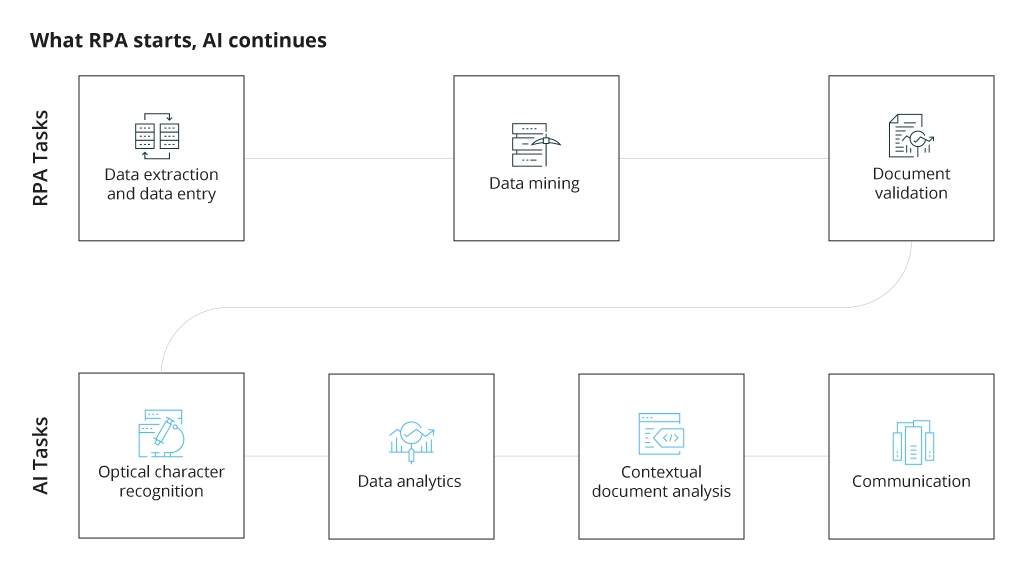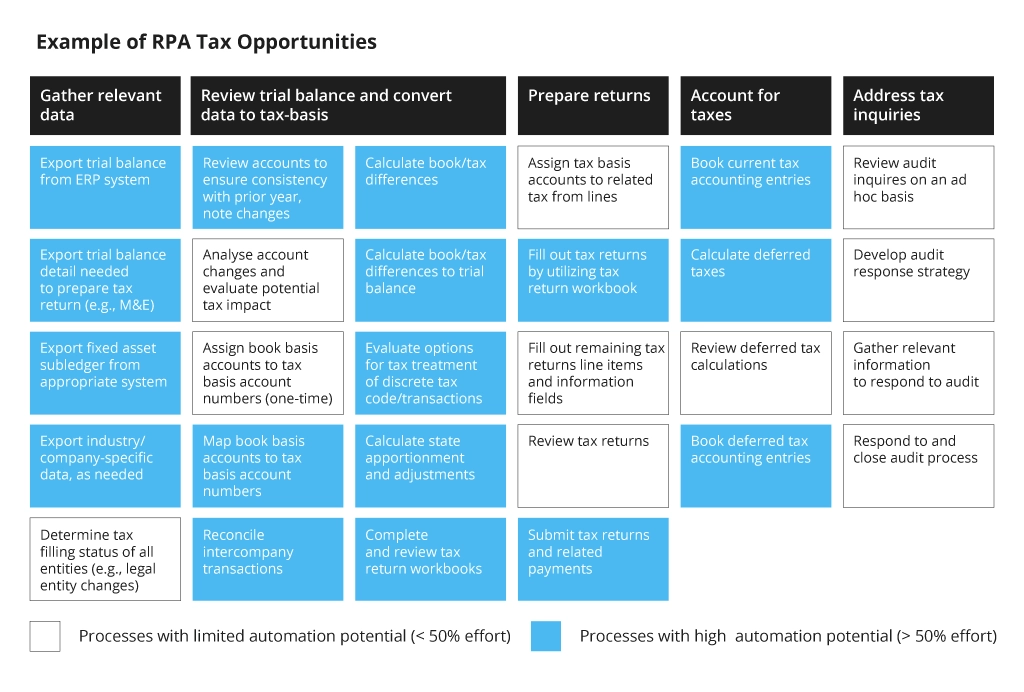AI and RPA Integration for Banking: Possibilities of Intelligent Automation
The banking and financial services industry are facing a dynamic nexus of challenges, ranging from shifting customer behaviour to increased regulatory scrutiny. At the same time, large tech companies are incorporating payment and lending capabilities to attract more users and, in some cases, disintermediate banks completely from crucial aspects of customer relationships and erode their revenue streams.
Individually, technologies like robotic process automation (RPA) and artificial intelligence (AI) have already proven to drive substantial gains for the sector, ranging from increased operating efficiencies and cost reduction to innovative product development. Further RPA and AI integration can help magnify these gains and scale them across a wider range of operating processes.
RPA and AI Integration: A Potent Combo for Financial Organizations
Robotic process automation (RPA) automates steps in various business processes using macros-based “bots”. These bots follow pre-defined rules to complete assigned tasks such as data entry, cross-checking, and validation. Instead of manually copy-pasting entries and switching between interfaces, your team can click a single button to reconcile a transaction, generate a bank statement, or cross-validate an invoice entry.
On average, organizations have 77 RPA processes in production, with 25% of enterprises having over 250 process automations in their estate, according to Blueprint. IT and Finance & Accounting functions comprise the bulk of adoption use cases.
However, RPA has its limitations. The technology can only support linear business processes, based on structured, well-defined data. An RPA bot, for example, may not be able to capture data from images or can fail to execute a command if there is a typo in the standard field description.
Rule-based bots are not capable of end-to-end process automation in banking processes that require analysis, judgment, or qualitative comparison — and that is exactly where artificial intelligence (AI) can take over.
Artificial intelligence refers to various techniques and methods used by computer systems to simulate human intelligence. These include machine learning, deep learning, computer vision, and more recently — generative AI.
By integrating RPA and AI, organizations can streamline more complex tasks, requiring text or sentiment analysis, document summarization, or statistical analysis of multiple documents.

Such intelligent automation (IA) allows banks to automate a wide range of backend and customer-facing business processes, ranging from new account openings to accounts payable management. For example, a bank can automate receiving, sorting, matching, validating, processing, and paying out invoices for the goods and services it receives by combining basic RPA with optical character recognition (OCR) and machine learning.
Discover other viable use cases of hyperautomation.
Having said that, not all business processes require AI per se. Standardized, rule-based business processes like “transaction data entry and validation”, “account reconciliation and balance checks”, and “document verification for new customers” among many others can be fully covered by custom RPA solutions.
An RPA/AI integration makes the most sense in cases where you would like to start processing unstructured data, enable self-service business analytics, or deploy conversational chatbots and copilots for your workforce and/or customers.
Benefits of Integrating AI with RPA
RPA automates a wide range of manual processes, requiring data manipulations. AI, in turn, facilitates data collection, analysis, and generation from a variety of different sources. By combining the two technologies, banking and financial service companies can streamline more complex workflows, which, in turn, leads to the following advantages.
Reduced Operating Costs
Automation decreases operational expenses. Adopters of the UiPath intelligent automation platform have reduced operating costs by $129 billion. Intelligent automation helps speed up process execution and decision-making, which lowers the expense per unit of output.
In addition to directly increasing labor productivity, intelligent automation solutions also facilitate cost savings in other areas like inventory management, procurement, and IT security, which also reduce operational expenses.
Optimized Workflows
An AI/RPA combo can cover more steps in the standard business processes, eliminating manual (and sometimes redundant) steps in execution. By adding AI to RPA, financial organizations can not only optimize task execution, but also enable new self-service analytics use cases, predictive analytics, and forecasting.
For example, a standard RPA solution can validate addresses for a mortgage application and cross-check data entries across the submitted documents. By adding optical charter recognition (OCR) to the process, assessors can also automatically analyze unstructured data (e.g., review flood certification orders in PDF or image format) or flag discrepancies between submitted documents and self-reported applicant data.
Machine learning algorithms have also proven their merit in financial fraud detection, outperforming traditional, rule-based methods for mobile fraud, capital market transactions, and credit card fraud among others.
Portuguese Caixa Geral de Depósitos (CGD), for example, deployed RPA for over 110 back-office and front-office processes, performed by 18 different departments. With the new system in place, the bank had saved over 370K hours in manual labor by the end of 2020.
Increased Accuracy
Traditional RPA solutions eliminate mistakes and inconsistencies by automating structured data processing. Machine learning and natural language processing (NLP) extend these capabilities to unstructured data — images, video, and audio. For example, optical character recognition (OCR) systems can recognize characters in images and PDF documents, facilitating data extraction and processing from a wider range of sources, further reducing the degree of manual data inputs.
NLP systems, in turn, can obtain data from audio and video recordings (e.g., customer support calls), as well as interact with text and spoken queries to provide self-service via an intelligent customer chatbot. By combining RPA and AI, market leaders are creating cross-channel conversational banking experiences to elevate new account opening processes, customer onboarding, account management, and customer service. For instance, Eno, a financial assistant from Capital One, can respond to over 2,200 different text-based customer queries, offering assistance with spending monitoring and account management. The algorithm also continuously learns from past interactions to deliver more personalized suggestions.
Improved Regulatory Compliance
Over 750 global regulatory bodies and governing businesses oversee the financial sector. A single mishap can lead to substantial fines and reputational losses. Intelligent automation solutions help ensure consistency, accuracy, and transparency in reporting. For instance, Infopulse has developed an RPA solution for financial reporting that can automatically collect data for the required period, highlight different types of discrepancies in reporting, and automatically reconcile indicators for the previous period to prepare financial statements.
Use Cases of AI/RPA Integration in Banking
About 80% of finance leaders have implemented or are planning to implement RPA and AI in the short term. The following use cases are among the top-priority ones.
Invoice Processing
Standard RPA bots can automate data extraction and validation from invoices, ensuring accurate processing and automatic data sync with other business systems (e.g., ERP). Advanced intelligent automation solutions, in turn, can automate more steps in the invoicing and billing processes such as work order generation, invoice routing, payment scheduling and processing, account reconciliation, and financial report generation. You can learn more about the benefits and approaches to invoice automation from our previous post.
Tax Management
“From a tax professional standpoint, we are always trying to shoehorn that data into some system. There is always an input that is required in a certain format,” Michele Donohue, a senior partner at Baker Tilly mentioned in an interview with Thomson Reuters. Because tax reporting and compliance are data-intensive processes, there are plenty of viable use cases for automation.
Specifically, intelligent automation can generate extra efficiencies when it comes to tasks like adjustment calculation, income tax compliance, transfer pricing, and ongoing tax accounting.
Unlike traditional RPA tools, intelligent solutions can also be adjusted to changes in the tax codes or reporting regulations, increasing the longevity and effectiveness of such systems.
Corporate Chatbots
RPA, combined with NLP and Generative AI, can create brand-new interactive experiences for banking customers and middle-office employees. Almost half (45%) of financial leaders plan to increase investments in chatbots and AI-enabled digital assistants this year.
AI-powered chatbots can replace the long waiting times on the phone and endless forms for customer service requests, elevating customer experience. That is an important factor since 73% of business leaders see a direct link between CX and business performance.
Apart from providing the first layer of customer support, intelligent automation solutions can also facilitate other customer support processes such as support ticket routing, customer request processing, and policy lookup by banking clerks.
In fact, thanks to the emerging retrieval-augmented generation (RAG) frameworks, organizations can now train in-house “GPTs”, which can parse internal documents to provide summarized responses, quote applicable policies, and provide text inputs that are based on the corporate materials. Microsoft already allows leveraging Azure OpenAI GPT models to create custom GPT-like applications, which can be trained on your proprietary data without risking any unwanted data exposure.
Finally, AI assistants can also help to better market the available products and services, personalizing the offers to the customers’ profiles. For example, Credit Mutuel expertly combines algorithmic recommendations with personalized reach by using an AI-powered email analyzer and four virtual assistants. This combination of technologies allows the bank to process over 350,000 online inquiries a day, helping the staff find relevant information 60% faster and make the most relevant recommendations out of its 200 products.
Conclusions
An RPA/AI integration is the next pivotal step in business process optimization, enabling financial leaders to cover more steps in the standard workflows to:
- Increase accuracy and reduce risks of errors
- Enhance employee productivity
- Obtain real-time data access and analytics.
The best part? Low-code platforms like Power Automate and Power Apps allow banks to handle a wider range of menial processes with the least developmental effort and allocate more professional developers to more advanced intelligent automation scenarios. Learn more about how to best approach the transition from RPA to intelligent automation in our previous post or contact Infopulse team directly for a personalized consultation.
![AI and RPA Integration for Banking [MB]](https://www.infopulse.com/uploads/media/banner-1920x528-ai-and-rpa-integration-for-banking-possibilities-of-intelligent-automation.webp)



![RPA KPIs and Metrics [thumbnail]](/uploads/media/thumbnail-280x222-how-to-measure-rpa-kpi-rpa-metrics.webp)
![RPA Bots in Agriculture [thumbnail]](/uploads/media/thumbnail-280x222-the-potential-of-RPA-bots-in-agri.webp)
![Robotic Invoice Process Automation [thumbnail]](/uploads/media/automating-invoicing-with-rpa-280x222.webp)
![RPA Licensing Cost Optimization Guide [thumbnail]](/uploads/media/thumbnail-280x222-a-guide-to-optimizing-licensing-costs-when-adopting-rpa.webp)
![RPA vs Intelligent Automation vs Hyperautomation [thumbnail]](/uploads/media/how-to-move-from-rpa-to-intelligent-automation-or-hyperautomation-280x222.webp)




![Cross-Industry RPA Benefits [thumbnail]](/uploads/media/cross-industry-benefits-of-robotic-process-automation-rpa-280x222_v2.webp)
